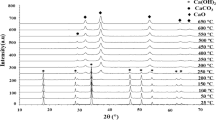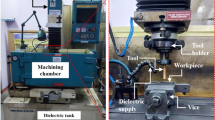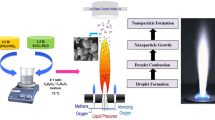Abstract
Zirconium (Zr) particles are coated with ferric oxyhydroxide (FeOOH) nanoparticles to form a core–shell structure, and this process alters the combustion performance of the zirconium particles. This study explored the flame propagation characteristics and combustion mechanism of FeOOH-coated zirconium particles. A high-speed observation system was used to reveal the flame propagation velocities and temperatures, and scanning electron microscopy, thermogravimetry (TG), and X-ray diffraction were used to examine and elucidate the combustion mechanism of FeOOH-coated zirconium particles. The results showed that when the concentration was increased, the flame propagation velocities of pure zirconium dust cloud were higher than those of FeOOH-coated zirconium dust cloud with the molar ratio of 1:6, which in turn were higher than the molar ratio of 1:3 due to the zirconium content. With increasing the concentration from 0.313 to 0.938 kg m−3, the temperatures of FeOOH-coated zirconium dust cloud with the molar ratio of 1:6 and 1:3 both were no peak. Moreover, the temperatures of FeOOH-coated zirconium dust cloud with the molar ratio of 1:6 were always higher than those with the molar ratio of 1:3. There were three phases of mass loss FeOOH-coated zirconium particles by TG test. The first phase of mass loss was because of evaporation of the FeOOH-coated zirconium particles, and the second phase of mass loss was the generation of Fe2O3 because of dehydroxylation of FeOOH. The third phase of mass loss was the residual of thermal decomposition due to Fe3O4 being formed from Fe2O3. It was also concluded that a replacement reaction occurred between Zr and Fe2O3 in the combustion process, and pure Fe is oxidized to Fe3O4 at high temperatures.










Similar content being viewed by others
Abbreviations
- C p :
-
Specific heat (J kg−1 K−1)
- d :
-
Point diameter of the thermocouple (m)
- k f :
-
Thermal conductivity of ambient air (W m−1 K−1)
- Nu :
-
Nusselt number, \(Nu = 2 + 0.6Re^{0.5} Pr^{0.33}\)
- Pr :
-
Prandtl number, \(Pr = \frac{{\mu C_{\text{p}} }}{k}\)
- Re :
-
Reynolds number, \(Re = \frac{\rho \nu D}{\eta }\)
- T :
-
Compensation of the temperature value measured by the thermocouple (°C)
- T m :
-
Temperature measured by the thermocouple (°C)
- τ :
-
Time constant of the thermocouple
- ρ :
-
Density (g cm−3)
References
David RL. Handbook of chemistry and physics. Boca Raton: CRC Press; 2007.
Knowledge of Rare Metal Editorial Committee. Zirconium and hafnium. Beijing: Metallurgical Industry Press; 1976 (in Chinese).
Xiong BK, Wen WG, Yang XM. Zirconium and hafnium metallurgy. Beijing: Metallurgical Industry Press; 2002 (in Chinese).
Doyle WL, Conway JB, Grosse AV. The combustion of zirconium in oxygen. J Inorg Nucl Chem. 1958;6(2):138–42.
Ewald KH, Anselmi-Tamburini U, Munir ZA. Combustion of zirconium powders in oxygen. Mater Sci Eng. 2000;291(1–2):118–30.
Ding YB, Sun JH, He XC, Wang QH, Yin Y, Xu Y, Chen XF. Flame propagation characteristics and flame structures of zirconium particle cloud in a small-scale chamber. Chin Sci Bull. 2010;55(34):3954–9.
Wang QH, Sun JH, Deng J. Flame temperature and propagation speed characteristics of zirconium dust cloud flame propagation in pipelines. J Univ Sci Technol. 2014;36(10):1378–83 (in Chinese).
Badiola C, Dreizin EL. Combustion of micron-sized particles of titanium and zirconium. Proc Combust Inst. 2013;34(2):2237–43.
Arblaster JW. Thermodynamic properties of zirconium. Calphad. 2013;43:32–9.
Elias E, Hasan D, Nekhamkin Y. Zirconium ignition in exposed fuel channel. Nucl Eng Des. 2015;286(1):205–10.
Akhian H, Hunt A, Cui X, Moewesb A, Szpunara J. The electronic structure of zirconium in hydrided and oxidized states. J Alloys Compd. 2015;622:463–70.
Milošević ND, Milošević ND. Thermophysical properties of solid phase zirconium at high temperatures. Int J Thermophys. 2006;27(4):1140–59.
Wang BM, Plavarthy R, Haque MA. Grain size-induced thermo-mechanical coupling in zirconium thin films. J Therm Anal Calorim. 2016;123(2):1197–204.
Holubar P, Jilek M. Sima M. Present and possible future applications of superhard nanocomposite coatings. Surf Coat Technol. 2000;133–34:145–51.
Caruso F. Nanoengineering of particle surfaces. Adv Mater. 2001;13:11–22.
Lv BL, Xu Y, Hou B, Wua D, Suna Y. Preparation and combustion properties of α-Fe2O3 coated Zr particles. Mater Res Bull. 2008;43:2769–77.
Lv BL, Xu Y, Hou B, Wua D, Suna Y. Preparation, characterization and combustion properties of Zr/ZrH2 particles coated with α-FeOOH crystal grains. Particuology. 2009;7:169–74.
Li Q. Transient flame propagation process and flame-speed oscillation phenomenon in a carbon dust cloud. Combust Flame. 2012;159(2):673–85.
Ballantyne A, Moss JB. Fine wire thermocouple measurement of fluctuating temperature. Combust Sci Flame Technol. 1977;17:63–72.
Sun JH, Dobashi R, Hirano T. Temperature profile across the combustion zone propagating through an iron particle cloud. J Loss Prevent Proc Ind. 2001;14(6):463–7.
Levitas VI, Pantoya ML, Dean SW. Melt dispersion mechanism for fast reaction of aluminum nano- and micron-scale particles: flame propagation and SEM studies. Combust Flame. 2014;161(6):1668–77.
Memon NK, Anjum DH, Chung SH. Multiple-diffusion flame synthesis of pure anatase and carbon-coated titanium dioxide nanoparticles. Combust Flame. 2013;160(9):1848–56.
Picquart M, López T, Gómez R, Torres E, Moreno A, Garcia J. Dehydration and crystallization process in sol–gel zirconia. J Therm Anal Calorim. 2004;76(3):755–61.
Surzhikov AP, Ghyngazov SA, Frangulyan TS, Vasil’ev IP. Thermal transformations in ultrafine plasmochemical zirconium dioxide powders. J Therm Anal Calorim. 2015;119(3):1603–9.
Acknowledgements
This work was supported by Scientific Research Program funded by National Natural Science Foundation of China (Grant No. 51504190); Open Project of State Key Laboratory of Fire Science, University of Science and Technology of China (Grant No. HZ2013-KF13); Shaanxi Provincial Education Department (Grant No. 2013JK0947); China Postdoctoral Science Foundation (Grant No. 2013M530430); Shaanxi Province Postdoctoral Science Foundation (Grant No. 2013-10-1-29); Postdoctoral Starting up Foundation of Xi’an University of Science and Technology (Grant No. 2016QDJ013); International Science and Technology Cooperation Project of Shaanxi Province (Grant No. 2016KW-070).
Author information
Authors and Affiliations
Corresponding author
Rights and permissions
About this article
Cite this article
Wang, Q., Deng, J., Sun, J. et al. Flame propagation characteristics and combustion mechanism of FeOOH-coated zirconium particles. J Therm Anal Calorim 126, 649–657 (2016). https://doi.org/10.1007/s10973-016-5545-0
Received:
Accepted:
Published:
Issue Date:
DOI: https://doi.org/10.1007/s10973-016-5545-0




